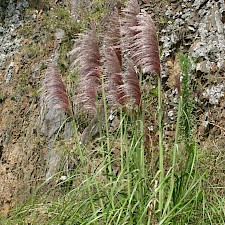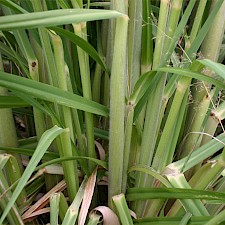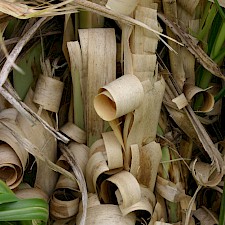Purple pampas
Botanical Name
Cortaderia jubata
Family
Poaceae (grass)
Also known as
Cutty grass, Prince-of-Wales’ feathers
Where is it originally from?
South America
What does it look like?
Large, clump-forming grass (<3 m+). Very hairy leaf base with no white waxy surface. Leaves have a wide conspicuous midrib which does not continue into leaf base, and there are no secondary veins between midrib and leaf edge. Both leaf surfaces are dark green, leaves snap readily when tugged, and dead leaf bases spiral like wood shavings. Dense, erect, fluffy, bright purple flowerheads (Jan-Mar) fade to a dirty brown at the end of the flowering season.
Are there any similar species?
Cortaderia selloana and native Austroderia species (toetoe). Toetoe leaves don't snap readily, have distinct secondary parallel veins between midrib and edge, midrib continues into leaf base, and leaves have white waxy sheaths. Dead leaves don't spiral. Drooping light golden-yellow flowers are produced from September to January.
Why is it weedy?
Tolerates heat and frost, salt, wind, wet and drought, moderate shade, most soils, and low fertility. Recovers quickly after fire. Prolific seeder and seeds are widely dispersed.
How does it spread?
Seeds are spread long distances by wind and occasionally water. Also spreads by soil movement, dumped vegetation, contaminated forestry machinery, clothing, animal pelts. Common seed sources are plantation forests, roadsides, farm hedges, quarries and wasteland.
What damage does it do?
Colonises sprayed, burnt, slipped or otherwise disturbed sites, quickly becomes very dense. Replaces groundcovers, shrubs, and ferns, creates fire hazard, provides a habitat for possums and rats, and impedes access. Normally followed by weedy vines.
Which habitats is it likely to invade?
Forest light gaps, slips, margins, disturbed sites, open habitats, riverbeds, cliffs, inshore and offshore islands, tussockland, fernland, herbfield, duneland, coastline, gumlands, salt marsh, estuaries, and shrublands.
What can I do to get rid of it?
Establish that the species is not toetoe (look for erect seed heads in autumn. Toetoe begins flowering in summer and has drooping, golden coloured seed heads)
1. Physical removal - Hand pull, dig out or grub the plant to ensure all of the plant crown is removed.
2. Foliar spray early spring to mid-summer when plants are actively growing (and before the plants produce flowers in late summer/autumn)
Apply Glyphosate (360 g/L active ingredient) herbicide at 10ml/L plus organosilicone penetrant 2ml/L to cover entire plant. Note: Glyphosate overspray will kill other (desirable) plants.
OR apply Haloxyfop herbicide (520g/l active ingredient at 3ml/L, or 100g/l active ingredient at 15ml/L ) to cover all parts of plant but not to the point it is dripping. Note: Haloxyfop herbicide is 'broadleaf friendly' but overspray will kill all grasses. Do not use over water bodies or wetlands and use only as directed on label.
Tip large areas of bare soil are ideal for this weed to establish. To avoid this, plant or sow desirable species to cover bare soil. Pampas seed can travel by wind over large distances. To contain spread, remove and dispose of flowerheads before they set seed.
CAUTION: When using any herbicide or pesticide, PLEASE READ THE LABEL THOROUGHLY to ensure that all instructions and directions for the purchase, use and storage of the product, are followed and adhered to.
What can I do to stop it coming back?
Wind-born seeds will reinfest bare, burnt and sprayed sites. Grazed plants will resprout. Pampas is not a strong competitor at germination and prefers full sun, so encourage weed replacement (seeding, planting, regeneration) as you carry out control. Planting bare areas with broadleaf species will allow for a grass selective herbicide to be used. Dead pampas plants will burn easily. Plan for increased fire risk after control.










